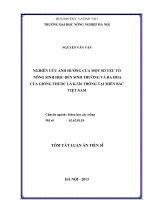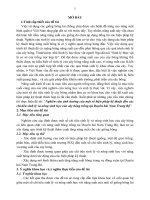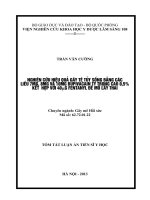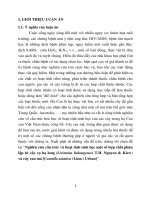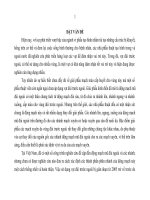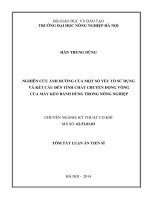(Luận án tiến sĩ) Nghiên cứu hiệu quả của hoạt động giao tiếp cùng thời điểm qua trung gian máy tính đối với việc phát triển kỹ năng ngôn ngữ cho sinh viên đại học Việt Nam
Bạn đang xem bản rút gọn của tài liệu. Xem và tải ngay bản đầy đủ của tài liệu tại đây (5.48 MB, 262 trang )
MINISTRY OF EDUCATION AND TRAINING
HUE UNIVERSITY
UNIVERSITY OF FOREIGN LANGUAGES
PHẠM ĐẶNG TRÂM ANH
AN INVESTIGATION INTO THE EFFECTS OF
SYNCHRONOUS COMPUTER MEDIATED COMMUNICATION
ON LANGUAGE SKILLS DEVELOPMENT FOR EFL
UNIVERSITY STUDENTS IN VIETNAM
DOCTOR OF PHILOSOPHY THESIS
THEORY AND METHODOLOGY OF ENGLISH LANGUAGE TEACHING
HUE, 2019
MINISTRY OF EDUCATION AND TRAINING
HUE UNIVERSITY
UNIVERSITY OF FOREIGN LANGUAGES
PHẠM ĐẶNG TRÂM ANH
AN INVESTIGATION INTO THE EFFECTS OF
SYNCHRONOUS COMPUTER MEDIATED COMMUNICATION
ON LANGUAGE SKILLS DEVELOPMENT FOR EFL
UNIVERSITY STUDENTS IN VIETNAM
DOCTOR OF PHILOSOPHY THESIS
THEORY AND METHODOLOGY OF ENGLISH LANGUAGE TEACHING
CODE: 9 14 01 11
SUPERVISORS:
Assoc. Professor TRAN VAN PHUOC
Assoc. Professor NGUYEN VAN LONG
HUE, 2019
BỘ GIÁO DỤC VÀ ĐÀO TẠO
ĐẠI HỌC HUẾ
TRƯỜNG ĐẠI HỌC NGOẠI NGỮ
PHẠM ĐẶNG TRÂM ANH
NGHIÊN CỨU HIỆU QUẢ CỦA GIAO TIẾP CÙNG
THỜI ĐIỂM QUA TRUNG GIAN MÁY TÍNH ĐỐI
VỚI VIỆC PHÁT TRIỂN KỸ NĂNG NGÔN NGỮ
CHO SINH VIÊN VIỆT NAM
LUẬN ÁN TIẾN SĨ
LÝ LUẬN VÀ PHƯƠNG PHÁP DẠY HỌC BỘ MÔN TIẾNG ANH
HUẾ, 2019
BỘ GIÁO DỤC VÀ ĐÀO TẠO
ĐẠI HỌC HUẾ
TRƯỜNG ĐẠI HỌC NGOẠI NGỮ
PHẠM ĐẶNG TRÂM ANH
NGHIÊN CỨU HIỆU QUẢ CỦA GIAO TIẾP CÙNG
THỜI ĐIỂM QUA TRUNG GIAN MÁY TÍNH ĐỐI
VỚI VIỆC PHÁT TRIỂN KỸ NĂNG NGÔN NGỮ
CHO SINH VIÊN VIỆT NAM
LUẬN ÁN TIẾN SĨ
LÝ LUẬN VÀ PHƯƠNG PHÁP DẠY HỌC BỘ MÔN TIẾNG ANH
MÃ SỐ: 9 14 01 11
Người hướng dẫn khoa học:
PGS. TS. TRẦN VĂN PHƯỚC
PGS. TS. NGUYỄN VĂN LONG
HUẾ, 2019
STATEMENT OF AUTHORSHIP
I hereby declare that I am the sole author of this doctoral dissertation and that I have
not used any sources other than those listed in the bibliography and identified as
references.
I further declare that I have not submitted this dissertation at any other institution in
order to obtain a degree.
Place:
Hue, Vietnam
Date:
July 5th, 2019
Signature:
i
ABSTRACT
The present study investigated the effects of synchronous computer-mediated
communication on the language development for Vietnamese EFL university
students. The research objectives aimed at examining the differences in oral and
written proficiency levels between the two treatment groups over the course of one
semester as well as exploring the students’ attitudes towards and perceptions of the
use of synchronous computer-mediated communication in language skills classes.
The research employed a pretest-posttest quasi-experimental design. Thirty
students from Danang University of Medical Technology and Pharmacy participated
in the research project. One class of English level 3 of CEFR – Vietnamese standard
(B1) participated in oral role plays and one class engaged in synchronous online
discussions. Data were collected from pre- and post- treatment tests at the beginning
and at the end of the semester. The research participants also filled out the pre- and
post- questionnaires to prevail their attitudes towards and perceptions of the use of
synchronous computer-mediated communication in language skills classes.
Additionally, semi-structured interviews were conducted with participants from the
SCMC chat group to verify the effects that synchronous online discussions might
have on language development for Vietnamese university students.
Results showed no statistically significant differences in oral and written
proficiency between the two treatment groups at the end of the semester. However,
there were statistically significant differences in pre- and post- treatment scores of
oral and written tests.
Other analyses of the oral transcripts and the written papers evolved that the
lexical richness had reasonably clear impacts on the oral and written test scores on
the basis of the described marking criteria. Results of lexical richness analysis
indicated a general increase in language although the difference in lexical richness
based on the two treatments was not detected.
Analysis of the questionnaires and semi-structured interviews exposed that
the one-semester English course enhanced learners’ language development. The
ii
students engaging in online discussions perceived them as beneficial for both their
oral and written language skills.
The fact that students perceived the online discussions as beneficial for their
oral speech, and the fact that there was no significant difference between the posttreatment oral and written proficiency of the two groups, corroborates the notion
that online discussions support the development of the same processes that underlie
oral speech. SCMC discussions are thus shown to be a valuable addition to the
foreign language classrooms.
Based on the findings, pedagogical implications on synchronous computermediated communication were put forward to English language skills classes.
iii
ACKNOWLEDGEMENTS
I would like to express my very great appreciation to all who have helped and
accompanied me along this arduous but worthwhile journey. All professors,
lecturers and supporters I have met during my coursework studies and the process
of writing this dissertation earn you my eternal gratitude.
I would like to express my deep gratitude to Assoc. Professor Dr. Tran Van
Phuoc, my research supervisor, for his patient guidance, enthusiastic encouragement
and useful critiques of this research work. He has always been by my side to share
his experience, professional development and challenges emerging from this long
journey.
I am particularly grateful for the assistance and professional guidance given by
Assoc. Professor Dr. Nguyen Van Long, my co-supervisor, during my process of
writing this dissertation. He has contributed significantly to my completion of the
PhD degree.
My special thanks are extended to Assoc. Professor Dr. Pham Thi Hong
Nhung, my lecturer and administrative supervisor, for her strong support from the
very beginning to the end of my PhD course. Her bright personality and integrity
impressed me profoundly.
Constructive comments and recommendations given by the panel members of
Hue University of Foreign Languages have been of great help to me in diving
deeper into the issues of computer-assisted English teaching and learning and
shaping the person I am today. My grateful thanks are also extended to Dr. Ton Nu
Nhu Huong, Dr. Tran Quang Ngoc Thuy and Assoc. Professor Dr. Le Pham Hoai
Huong for their advice and assistance in revising the research title, scope of the
study and research questions.
My gratitude also goes to the lecturers of Hue University of Foreign
Languages: Dr. Bao Kham, Assoc. Prof. Dr. Truong Vien, and Dr. Pham Hoa Hiep
who have given me interesting lectures in TESOL and guided me through the
fulfillment of this thesis.
iv
I wish to acknowledge the help provided by Assoc. Professor Dr. Nguyen
Khac Minh, Rector, for his granting me study leave and implementation of my
research project at the Danang University of Technology and Pharmacy. I would
also like to thank the librarians of my University for assisting me in teaching at the
computer labs and collecting the research data as well as my colleagues for taking
up my workload while I was doing my PhD degree.
My big thanks go to Ms. Dang Thi Le Thu who never stopped believing that I
could do this and who gave me her unwavering emotional and technical support.
Ms. Tran Thi Hoai Vi was a great help with technical questions regarding SPSS
software.
Finally, I wish to thank my family for their support and encouragement
throughout my study.
Without them, I would not be able to reach the finishing line of this
meaningful journey.
v
LIST OF ABBREVIATIONS
ANOVA
Analysis of variance
ASCMC
Asynchronous computer-mediated communication
CALL
Computer assisted language learning
CEFR
Common European Framework of Reference
CMC
Computer-mediated communication
DUMTP
Danang University of Medical Technology and Pharmacy
EFL
English as a foreign language
ESL
English as a second language
ESP
English for Specific Purposes
FTF
Face to face
ICT
Information and communication technology
L1
First language
L2
Second language
MOET
Ministry of Education and Training
PET
Preliminary English Test
SCMC
Synchronous computer-mediated communication
SCT
Socio-cultural theory
SLA
Second language acquisition
VSTEP
Vietnamese Standardized Test of English Proficiency
ZPD
Zone of Proximal Development
vi
LIST OF TABLES
Table 1.1. Subjects of semester one ............................................................................ 3
Table 3.1. Selected background information ............................................................ 46
Table 3.2. Perceived English language proficiency between the two groups .......... 47
Table 3.3. Self-rating of computer experience: Descriptive statistics ...................... 49
Table 3.4. Students’ attitude towards computers ...................................................... 50
Table 3.5. Perceived benefits of internet-connected computers ............................... 51
Table 3.6. Mean scores of pre-treatment oral and written proficiency tests ............ 52
Table 3.7. Schedule for the fieldwork study (15 weeks) .......................................... 58
Table 3.8. Overview of the research procedures ...................................................... 61
Table 3.9. Data types and collection methods .......................................................... 66
Table 4.1. Mean and Standard deviation for oral and written proficiency tests ....... 74
Table 4.2. Mean and Standard deviation for pre- and post- oral and written tests ... 76
Table 4.3. ANOVA: T-test: Paired samples test....................................................... 77
Table 4.4. Quantity of language: Oral test ................................................................ 79
Table 4.5. Quantity of language: Written test........................................................... 82
Table 4.6. Lexical diversity: Oral test ...................................................................... 85
Table 4.7. Lexical diversity: Written test ................................................................. 88
Table 4.8. Lexical density: Oral test ......................................................................... 90
Table 4.9. Lexical density: Written test .................................................................... 92
Table 4.10. Mean and Standard deviation for post-treatment lexical features ......... 95
Table 4.11. Perceived effects of non-SCMC role play and SCMC chat on language
development .............................................................................................................. 96
Table 4.12. Perceived effects of non-SCMC role play and SCMC chat on the four
language skills........................................................................................................... 98
Table 4.13. Perceived effects of non-SCMC role play and SCMC chat on language
areas ........................................................................................................................ 102
Table 4.14. Perceived effects of non-SCMC role play and SCMC chat on future
impact...................................................................................................................... 104
Table 4.15. Students’ experience with oral role play and written chat .................. 106
vii
Table 4.16. Perceptions of anxiety during non-SCMC role play and SCMC chat . 109
Table 4.17. Monitoring mistakes of non-SCMC role play and SCMC chat .......... 111
Table 4.18. Requirements of oral role play and written chat ................................. 112
Table 4.19. Perceptions of online discussions by SCMC chat group ..................... 114
viii
LIST OF PICTURES AND FIGURES
Picture 3.1. Non-SCMC role play group in the computer lab .................................. 57
Picture 3.2. Instructor’s desktop during the chat discussion .................................... 58
Graph 4.1. Lexical diversity and transcript length in post-treatment: Oral test ....... 87
Graph 4.2. Lexical diversity and text length in pre-treatment: Written test ............. 89
Figure 4.1. Suggested model of language skills development using SCMC .......... 116
ix
APPENDICES
Appendix 1 Consent form .................................................................................... 151
Appendix 2 Pre-treatment questionnaire ............................................................. 152
Appendix 3 Cronbach’s alpha – Pre-treatment questionnaire ............................. 157
Appendix 4 Post-treatment questionnaire – Non-SCMC Role play group.......... 159
Appendix 5 Cronbach alpha – Post- questionnaire – Non-SCMC Role play group162
Appendix 6 Post-treatment questionnaire – SCMC chat group........................... 163
Appendix 7 Cronbach’s alpha – Post- questionnaire – SCMC chat group.......... 166
Appendix 8 Post-treatment interview – SCMC chat group ................................. 168
Appendix 9 Post-treatment interview transcript sample – SCMC chat group..... 169
Appendix 10 Pre- and Post-treatment oral test questions .................................... 171
Appendix 11 Transcript sample of a pre-oral proficiency test ............................. 174
Appendix 12 Transcript sample of a post-oral proficiency test ............................ 176
Appendix 13 Rating scale for the written test (Level 3-5 VSTEP) ..................... 178
Appendix 14 Pre- written proficiency test prompt .............................................. 183
Appendix 15 Sample of a pre- written proficiency test ......................................... 184
Appendix 16 Post- written proficiency test prompt ............................................... 185
Appendix 17
Sample of a post - written proficiency test .................................... 186
Appendix 18 Rating scale for the written test (Level 3-5 VSTEP) ...................... 187
Appendix 19 Pre- and post-treatment proficiency test result ............................... 190
Appendix 20 Pre- and post-treatment proficiency test result ................................ 191
Appendix 21 Lab tasks .......................................................................................... 192
Appendix 22 A chat sample downloaded from Hangout program of Gmail ........ 194
Appendix 23 Analysis of variance (ANOVA) and score difference between the two
groups
.......................................................................................................... 198
Appendix 24 Paired samples test ........................................................................... 200
Appendix 25 Lexical diversity: Oral test ............................................................... 205
Appendix 26 Lexical density: Oral test ................................................................. 207
Appendix 27 Lexical diversity: Written test .......................................................... 209
Appendix 28 Lexical density: Written test ............................................................ 211
x
Appendix 29 Descriptive statistics: Self-rating of English language proficiency . 213
Appendix 30 Descriptive statistics: Attitude towards computer ........................... 218
Appendix 31 Descriptive statistics: Self-rating of computer experience .............. 220
Appendix 32 Descriptive statistics: Perceptions of internet-connected computers222
Appendix 33 Mean and Standard deviation: Post-treatment questionnaire .......... 224
Appendix 34 Lexical features: Descriptive statistics ........................................... 229
Appendix 35 Approval to conduct research at DUMTP ...................................... 231
Appendix 36 Syllabus for English intensive program .......................................... 232
Appendix 37 Syllabus for English for specific purposes ..................................... 239
xi
TABLE OF CONTENTS
Statement of authorship ............................................................................................... i
Abstract ....................................................................................................................... ii
Acknowledgements .................................................................................................... iv
List of abbreviations .................................................................................................. vi
List of tables.............................................................................................................. vii
List of pictures and figures ........................................................................................ ix
Table of contents ....................................................................................................... xii
Chapter 1. Introduction ........................................................................................... 1
1.1. Introduction ...................................................................................................... 1
1.2. Research setting ................................................................................................ 2
1.2.1. Institution ................................................................................................... 2
1.2.2. Students ...................................................................................................... 2
1.2.3. Use of technology ...................................................................................... 6
1.3. Research questions ........................................................................................... 7
1.4. Rationale of the study ....................................................................................... 8
1.5. Structure of the dissertation ............................................................................ 11
1.6. Chapter summary ........................................................................................... 12
Chapter 2. Literature Review ................................................................................ 13
2.1. Introduction .................................................................................................... 13
2.2. Definitions of key terms ................................................................................. 13
2.3. Theoretical framework of the study ............................................................... 15
2.3.1. Constructivism in socio-cultural theory ................................................... 15
2.3.2. Computer-mediated communication and socio-cultural theory............... 18
2.3.3. Computer-mediated communication and language development ............ 20
2.3.4. Computer-mediated communication and second language acquisition
theories ............................................................................................................... 21
2.4. Research on computer-mediated communication .......................................... 25
2.4.1. Synchronous computer-mediated communication ................................... 25
2.4.2. Transfer from synchronous online discussions to oral abilities ............... 29
2.4.3. Quantity and complexity of language ...................................................... 32
2.5. English language education in Vietnam ......................................................... 34
2.5.1. Vietnamese EFL learners’ current language proficiency ........................ 34
2.5.2. Why can CMC help Vietnamese EFL learners? ...................................... 36
xii
2.6. Research gap ................................................................................................... 40
2.7. Chapter summary ........................................................................................... 41
Chapter 3. Methodology ......................................................................................... 42
3.1. Introduction .................................................................................................... 42
3.2. Research design .............................................................................................. 42
3.3. Research participants ...................................................................................... 45
3.4. Ethical considerations..................................................................................... 52
3.5. Research Procedures....................................................................................... 53
3.6. Data collection methods ................................................................................. 62
3.6.1. Oral proficiency tests ............................................................................... 62
3.6.2. Written proficiency tests.......................................................................... 63
3.6.3. Pre-treatment questionnaire ..................................................................... 63
3.6.4. Post-treatment questionnaire ................................................................... 64
3.6.5. Post-treatment interview .......................................................................... 65
3.7. Data analysis ................................................................................................... 67
3.7.1. Comparison of scores ............................................................................... 67
3.7.2. Analysis of lexical features ...................................................................... 67
3.7.3. Students’ perceptions of the treatment ..................................................... 70
3.8. Research reliability and validity ..................................................................... 70
3.8. Chapter summary ........................................................................................... 71
Chapter 4. Findings and discussion ...................................................................... 73
4.1. Introduction .................................................................................................... 73
4.2. Findings of the study ...................................................................................... 73
4.2.1. Comparison of pre- and post- treatment scores ....................................... 73
4.2.2. Analysis of lexical features ...................................................................... 78
4.2.2.1. Quantity of language ......................................................................... 78
4.2.2.2. Lexical richness ................................................................................. 84
4.2.2.3. Comparison of lexical features between the two treatment groups... 94
4.2.3. Students’ perceptions of and attitude towards the treatment ................... 95
4.2.3.1. Perceived effects of non-SCMC role play and SCMC chat .............. 96
4.2.3.2. Students’ evaluation of non-SCMC role play and SCMC chat ....... 106
4.2.3.3. SCMC chat group’s perceptions of the treatment ........................... 113
4.2.4. Suggested model of language skills development using SCMC ........... 114
4.3. Discussion of the key findings ..................................................................... 116
xiii
4.3.1. Comparison of pre- and post- treatment scores ..................................... 117
4.3.2. Lexical features ..................................................................................... 119
4.3.3. SCMC chat group’s perceptions of the treatment ................................. 122
4.4. Chapter summary ......................................................................................... 127
Chapter 5. Conclusion and Implications ............................................................ 128
5.1. Introduction .................................................................................................. 128
5.2. Summary of key findings ............................................................................. 128
5.3. Implications .................................................................................................. 132
5.3.1. Theoretical implications ......................................................................... 132
5.3.2. Methodological implications ................................................................. 132
5.3.3. Pedagogical implications ....................................................................... 133
5.4. Limitations of this study and Future research .............................................. 136
5.5. Conclusion .................................................................................................... 138
AUTHOR’S PUBLICATIONS ............................................................................ 139
REFERENCES...................................................................................................... 140
APPENDICES ....................................................................................................... 151
xiv
Chapter 1
Introduction
1.1. Introduction
Research on computer mediated communication (CMC) has shown an
outstanding development on foreign/second language teaching and learning
methodology using technology of which countless benefits have been proved
through numerous world-wide research studies (Abdorreza, Jaleh, & Azadeh, 2015;
Abrams, 2003; Bui, 2006; Chou, 2004; Dang, 2011). Gonzalez-Lloret (2011)
assumed that CMC was one of the fastest growing communicative media in the
world and produced large quantities of authentic materials for instructors and
learners around the world.
Generally, CMC which refers to discussions via computer as a medium of
communication has two modes. The first, asynchronous computer-mediated
communication (ASCMC), takes place in time and place independence. Typically,
the instructor and students discuss, give and get information or deliver materials
through course web pages, posting of forum messages or email messages. In
contrast, synchronous computer-mediated communication (SCMC) represents realtime interactions. Usually, this means that the instructor and students meet in a chat
room, simultaneously, at a particular location in cyberspace or from any location
that has Internet access and interact through typed statements or questions (Lavooy
& Newlin, 2003).
The advantages of using SCMC have been so far touched on a variety of
research publications, the aim of this study is to explore experimental insights into
applicability of SCMC mode for Vietnamese EFL students’ language skills
development. The present study investigates the effects of SCMC on the
development of oral and written proficiency of EFL university students of Vietnam
over the course of a fifteen-week semester. The research also explores students’
perceptions of and attitudes towards SCMC mode as well as their progress on
language skills through SCMC activities.
1
1.2. Research setting
This section describes an overview of the institution, the students, the use of
technology in language teaching and learning of the present study.
1.2.1. Institution
The research was implemented at the Danang University of Medical
Technology and Pharmacy (DUMTP) under Vietnam Ministry of Health. The first
campus is located at 99 Hung Vuong street in Hai Chau district and the second one
at Nam Ky Khoi Nghia street in Ngu Hanh Son district of Danang city. The total
area is 62,093 m2. The total number of students at the time of the research being
done in the academic year 2017-2018 was 4,402 students. DUMTP is a public
school belonging to the Vietnamese educational system. Its mission is to train health
staff at undergraduate and post graduate levels in order to meet the requirements of
health human resources and people’s health care and protection.
Major training programs of DUMTP in the academic year of 2017-2018 were
6-year-curriculum General Practitioner, 5-year-curriculum Pharmacist and 4-yearcurriculum Bachelors of Public Health, Medical Imaging, Medical Laboratory,
Rehabilitation, General Nursing, Dental Nursing and Anesthesia Resuscitation
Nursing.
While General Practitioner program was lately introduced in DUMTP in
2015, the other ones have been offered over a long history of establishment since
1963. They shared many common subjects, except for some specialized ones
particular to the individual discipline. The participants involved in this research
were General Practitioner students. The investigation was conducted in their first
semester of the first academic year out of twelve semesters within six years they
studied at DUMTP.
1.2.2. Students
Enrolment in the academic year 2017-2018 of DUMTP where the research
was done was about 750 new students from all over Vietnam. Based on the
enrolment regulations by Ministry of Education and Training for the academic year
2017-2018, the candidates submitted their application forms online or directly at the
2
campus. The requirements of enrolment were: passing the national high school
graduation examination of which the three subjects of Mathematics, Chemistry and
Biology had to be taken by the candidates; the score for admission had to be at least
at the threshold point to meet entry quality requirement at the provision of Ministry
of Education and Training and be selected from the highest points to the number of
admission criteria, for example, 750 new students in the academic year 2017-2018
for DUMTP.
100 General Practitioner fresh students were admitted to DUMTP in 20172018, making up the total of 300 students in General Practitioner major at DUMTP
at the time of this research being carried out. The first-year students were randomly
assigned into two different classes of 50 each. It was in these classes they would
stay together for the full six years of the program.
In order to get a General Practitioner degree, students had to pass around 230
credits divided into 90 subjects, not including Practicum and Field Placement,
which were roughly equally allocated in twelve semesters within the six-year
period. The subjects were classified as General Education Knowledge, Basic
Professional Knowledge, Professional Knowledge and Complimentary Knowledge.
The following was a part of the training curriculum for General Practitioner
program in semester one (out of twelve semesters).
Table 1.1. Subjects of semester one
No.
Number of credits
Subjects
Theory
Practice
1
Principle of Marxist-Leninist Philosophy 1
2
0
2
English for Specific Purposes 1
3
0
3
General Information Technology
1
1
4
Physical Education
1
2
5
Biophysics
2
1
6
Biostatistics
1
1
Total
10
5
3
Total number of school subjects that students would study in this semester
was 6 subjects with 10 theoretical and 5 practical credits. One credit equaled 15 inclass hours teaching theory, or 30 preclinical-practice hours at campus labs, or 45
clinical-practice hours at hospitals. It was stipulated for all courses that one class
hour (either theory or practice) lasts 50 minutes. It was also noted that these were
compulsory subjects, like all other subjects throughout the twelve semesters of the
General Practitioner program. The schedule followed the given chronological order
in compliance with the curriculum, learning materials, delivery methods made from
the university board, ministerial and teacher-centered viewpoint, without taking
students’ viewpoints and perceptions into consideration.
Regarding ESP requirements, ESP is a compulsory subject in General
Practitioner major’s official training curriculum. The students have to obtain 9
credits of ESP during their six-year study to fulfill the graduation requirements. The
objectives of this ESP 1 module are to equip students with necessary vocabulary,
medical terms, and grammatical structures aiming at supporting four language skills
(listening, speaking, reading and writing) focusing on communication themes about
hospital environment; and to practice English professional conversations between
doctors and patients as well as doctors with their colleagues. Within 3 credits
equivalent to 45 class hours, the students acquire a big quantity of medical terms,
grammatical structures used in hospital and clinic conversations relating to lab
practice, clinical practice and treatment so that the students are able to communicate
English in their future working environment after graduation. The contents of ESP 1
module include following 5 lessons: presenting complaints; working in general
practice; giving instructions and procedures; explaining and reassuring; and dealing
with medication (please see Appendix 37 – p.239 for detailed syllabus).
After eighteen years teaching English at DUMTP, the researcher identified
the following hindrances to the students: firstly the switch from relatively traditional
method at high school to a quite different, rather communicative approach; secondly
from general English to ESP (medical English particularly to General Practitioner
program). During the first year studying at DUMTP, many students are reported to
4
suffer from stress due to the conflict between the familiar teacher-centered
classrooms and the unfamiliar learner-centered ones, similarly to many other
researchers stating earlier in their studies on Vietnamese EFL students: Sullivan
(2000), Nguyen (2011). According to Bui (2006) and Tomlinson & Dat (2004),
Vietnamese students have a minimum of eleven years of learning English but ample
evidence shows that a high proportion of these students are hardly able to
communicate in English, after such a number of years, simply because of shyness,
inadequate vocabulary, or a lack of the necessary communicative knowledge.
Moreover, they have many difficulties in speaking and understanding their English
university lecturers who use mainly English for classroom instruction, owing to the
lack of previous contact with English-speaking environment at high school. The key
elements leading to this drawback addressed by Nguyen, Fehring, & Warren (2015)
were: not enough class time for teaching English speaking and communication, no
speaking tests in the examinations, big class sizes, teacher quality, and limited
programs for teachers’ professional development.
For the purpose of helping the first-year students overcome these hindrances
in EFL learning, the researcher wished to consolidate their general English and
provide them with opportunities to practice their language skills on daily activities
as well as functional conversations via computer-mediated communication so that
they would be more confident following ESP modules in their formal curriculum
which were expected to be ambitious and challenging with strange and complicated
medical terms different from what they had learned at high school. This intensive
course would be provided in the first semester just as they started their university
training curriculum because of the following reasons: firstly, they had opportunities
to be accustomed with rather communicative language teaching approach in parallel
with their formal ESP module; secondly, the schedule was not so tight as it would
be in the following semesters when they started doing their practice at hospitals.
In view of the above-mentioned reasons, an English intensive course was
designed to provide students with daily conversations, grammar and vocabulary
equivalent to level 3 of the Vietnamese six-level framework of reference for foreign
5
languages (B1-CEFR) with the purpose of intensifying communication skills in
English for students as emphasized by the National Foreign Language Project 2020
by Prime Ministry of Vietnam. The course lasted 10 weeks with 4 contact hours
each in the computer lab of DUMTP.
To be successful in the additional English course, students to some extent
needed computer skills. Therefore, an exploration into their computer experience
was done by the researcher before the course started.
1.2.3. Use of technology
It was reported that Vietnamese EFL students used computers mainly for
personal pleasure and entertainment such as chatting, and exchanging emails with
friends, writing blogs and wikis, having diaries on Twitter, or posting photos and
statuses and commenting on the more popular social network Facebook (Dang,
2011). It has been recently observed that a few students used private messages on
Facebook to discuss their study or their group assignment work. A limited number
of students received lectures, learning materials or feedback from their teachers via
emails. While the uses of multimedia computers and the Internet have grown
rapidly in ESL/EFL teaching and learning settings worldwide, the scenario of
technology applications in education in Vietnam is just at the beginning stages
(Peeraer & Van Petegem, 2010).
Along with the aforementioned reasons, the current teaching and learning
contexts in Vietnam as well as the government’s call for applying technological
tools in education to improve the quality of EFL education makes technology highly
desirable (Vietnamese Government, 2008a). Introduction of technology in general
and CMC in particular to educational purposes was one of the missions of the
current study with the expectation of reducing the burden for teachers, increasing
students’ level of autonomy and at the same time expanding the learning
possibilities beyond the classroom wall.
From the scenario of the limited applications of CMC in teaching and
learning practice in the current context, Vietnam needs to speed up, invest, research,
and explore more about CMC applications in the classrooms to get the benefits that
technological tools can bring (Dang, 2011). The present study aims to explore the
6
effects of SCMC on the language development of Vietnamese EFL students over
the course of a fifteen- week semester. The expected outcome might be that there
would be some improvement on experimental participants’ oral and written
proficiency and the students would perceive some benefits for their language skills.
CMC discussions will be thus shown to be a valuable addition to the foreign
language classrooms in the Vietnamese socio-cultural context, in terms of second
language acquisition and learners’ language skills development.
1.3. Research questions
The current study aims to investigate the effects of two different treatments,
including oral role plays and synchronous online discussions, both of which are
often used in the foreign language classroom, on the development of oral and
written proficiency.
A quasi-experimental design was chosen for this study. The present study
used two “intact” classes to do experiment over one semester of 10 sessions with 4
hours each. This was a mixed study in which both quantitative and qualitative data
were analyzed. The mixed study used a pretest and posttest design to measure the
participants’ oral and written proficiency as well as pre- and post-questionnaires and
semi-structured interviews to record the participants’ perceptions on CMC.
In current dissertation, SCMC chat group involves students who engage in
role play activities via computer-mediated discussion, which is used interchangeably as
synchronous online discussion, written chat, or chat. Respectively, non-SCMC role
play group refers to students who take part in role play activities through face-to-face
discussion, which is used interchangeably as oral role play, or face-to-face discussion.
The current study aims to contribute to our understanding of the necessity of
technology application in EFL classrooms by investigating whether SCMC has an
effect on the development of oral and written proficiency of EFL university students
in the Vietnamese context. The research was guided by the following three research
questions:
1. To what extent are EFL learners’ levels of oral proficiency different between
non-SCMC role play group and SCMC chat group after a fifteen-week
semester? The extent of difference, if any, is determined as follows:
7

